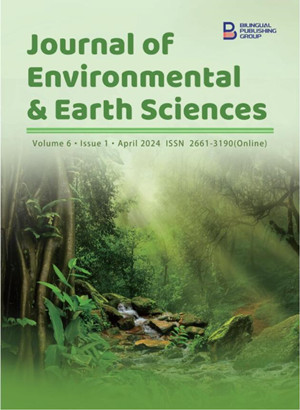
About Some Aspects of Use of Optical Sensors for Monitoring the Aquatic Environment
DOI:
https://doi.org/10.30564/jees.v6i1.6006Abstract
Multi-channel polarization optical technology is increasingly used for prompt monitoring of water systems. Optical devices during the assessment of water quality determine the intensity of light through the studied aquatic environment. Spectrophotometric devices measure the spectrum of weakening of light through the aquatic environment. Spectroellipsometric devices receive spectra in vertical and horizontal polarizations. The presented article develops an adaptive optical hardware and image system for monitoring water bodies. The system is combined. It consists of 2 parts: 1) automated spectrophotometer-refractometer, and 2) adaptive spectroellipsometer. The system is equipped with a corresponding algorithmic and software, including algorithms for identifying spectral curves, databases and knowledge of spectral curves algorithms for solving reverse problems. The presented system is original since it differs from modern foreign systems by a new method of spectrophotometric and spectroellipsometric measurements, an original elemental base of polarization optics and a comprehensive mathematical approach to assessing the quality of a water body. There are no rotating polarization elements in the system. Therefore, this makes it possible to increase the signal-to-noise ratio and, as a result, improve measurement stability and simplify multichannel spectrophotometers and spectroellipsometers. The proposed system can be used in various water systems where it is necessary to assess water quality or identify the presence of a certain set of chemical elements.
Keywords:
Monitoring; Aquatic environment; Polarization optics; Water object; Pollutants; Spectral images; Classification; IdentificationReferences
[1] Mkrtchyan, F.A., Varotsos, C.A., 2018. A new monitoring system for the surface marine anomalies. Water, Air, & Soil Pollution. 229, 1–10. DOI: https://doi.org/10.1007/s11270-018-3938-3
[2] Mkrtchyan, F.A. (editor), 2018. On the effectiveness of remote monitoring systems. Earth Observing Systems XXIII; 2018 Sep 7; San Diego, California, United States. 10764, 361–367. DOI: https://doi.org/10.1117/12.2322522
[3] Kovalev, V.I., Rukovishnikov, A.I., Kovalev, S.V., et al., 2016. LED broadband spectral ellipsometer with switching of orthogonal polarization states. Journal of Optical Technology. 83(3), 181–184. DOI: https://doi.org/10.1364/JOT.83.000181
[4] Kovalev, V.I., Rukovishnikov, A.I., Kovalev, S.V., et al., 2014. An LED multichannel spectral ellipsometer with binary modulation of the polarization state. Instruments and Experimental Techniques. 57, 607–610. DOI: https://doi.org/10.1134/S002044121405008X
[5] Kovalev, V.I., Ali, M., Kovalev, S.V., et al., 2014. Possibilities of achromatization of coaxial asymmetric phase shifters with an even number of reflections. Optics and Spectroscopy. 117, 118–120. DOI: https://doi.org/10.1134/S0030400X1407011X
[6] Krapivin, V.F., Nitu, C., Mkrtchyan, F.A., et al., 2018. Information-instrumental tools of microwave and optical environmental monitoring. The Scientific Bulletin of Electrical Engineering Faculty. 18(1), 11–18. DOI: https://doi.org/10.1515/sbeef-2017-0016
[7] Mkrtchyan, F.A., Krapivin, V.F., Kovalev, V.I., et al., 2009. An adaptive spectroellipsometric technology for ecological monitoring of sea water. PICES Scientific Report. 36, 215–218.
[8] Mkrtchyan, F.A., Krapivin, V.F., Kovalev, V.I., et al., 2009. An adaptive spectroellipsometer for ecological monitoring. Microwave and Optical Technology Letters. 51(11), 2792–2795. DOI: https://doi.org/10.1002/mop.24730
[9] Lazareva, O., Kan, J., Chen, C., et al., 2022. Coupled dynamics of aqueous biogeochemistry in contrasting floodplain environments: Implications for Critical Zone carbon sequestration along redox gradients. Applied Geochemistry. 145, 105413. DOI: https://doi.org/10.1016/j.apgeochem.2022.105413
[10] Liao, F., Wang, G., Shi, Z., et al., 2018. Distributions, sources, and species of heavy metals/trace elements in shallow groundwater around the Poyang Lake, East China. Exposure and Health. 10, 211–227. DOI: https://doi.org/10.1007/s12403-017-0256-8
[11] Mkrtchyan, F.A., Krapivin, V.F., Kovalev, V.I., et al. (editors), 2010. An adaptive spectroellipsometric identifier for ecological monitoring of the aquatic environment. PIERS 2010 Cambridge-Progress in Electromagnetics Research Symposium; 2010 Jul 5-8; Cambridge, USA. p. 365–368. (in Russian).
[12] Plana, Q., Alferes, J., Fuks, K., et al., 2019. Towards a water quality database for raw and validated data with emphasis on structured metadata. Water Quality Research Journal. 54(1), 1–9. DOI: https://doi.org/10.2166/wqrj.2018.013
[13] Prasad, A.N., Mamun, K.A., Islam, F.R., et al. (editors), 2015. Smart water quality monitoring system. 2015 2nd Asia-Pacific World Congress on Computer Science and Engineering (APWC on CSE); 2015 Dec 2–4; Nadi, Fiji. New York: IEEE. p. 1–6. DOI: https://doi.org/10.1109/APWCCSE.2015.7476234
[14] Varotsos, C.A., Krapivin, V.F., Mkrtchyan, F.A., 2019. New optical tools for water quality diagnostics. Water, Air, & Soil Pollution. 230, 1–12. DOI: https://doi.org/10.1007/s11270-019-4228-4
[15] Mkrtchyan, F.A., Krapivin, V.F., Klimov, V.V. (editors), 2019. The possibilities of using LED photometry and ellipsometry technology for monitoring the aquatic anvironment. 2019 Photonics & Electromagnetics Research Symposium-Spring (PIERS-Spring); 2019 Jun 17–20; Rome, Italy. New York: IEEE. p. 908–914. DOI: https://doi.org/10.1109/PIERS-Spring46901.2019.9017591
[16] Nitu, C., Krapivin, V.F., Mkrtchyan, F.A., 2020. Advanced ecology. Monitoring, diagnostics, prognosis. Vol. 1. Matrix Rom: Bucharesti. pp. 1–396.
[17] Nitu, C., Krapivin, V.F., Mkrtchyan, F.A., 2021. Advanced ecology. Monitoring, diagnostics, prognosis. Vol. 2. Matrix Rom: Bucharesti. pp. 1–374.
Downloads
How to Cite
Issue
Article Type
License
Copyright © 2023 Author(s)

This is an open access article under the Creative Commons Attribution-NonCommercial 4.0 International (CC BY-NC 4.0) License.







 Ferdenant Mkrtchyan
Ferdenant Mkrtchyan






